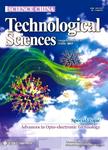A systematic understanding of microbial reductive dechlorination towards an improved “one health” soil bioremediation: A review and perspective
作者机构:Zhejiang Provincial Key Laboratory of Agricultural Resources and EnvironmentInstitute of Soil and Water Resources and Environmental ScienceCollege of Environmental and Resource SciencesZhejiang University Key Laboratory of Environment Remediation and Ecological HealthMinistry of Education Microbiome Network and Department of Agricultural BiologyColorado State University Departments of Chemistry and Chemical & Biomolecular EngineeringInstitute for Functional Intelligent Materials (I-FIM)National University of Singapore
出 版 物:《Science China Technological Sciences》 (中国科学:技术科学(英文版))
年 卷 期:2024年第67卷第10期
页 面:3009-3031页
核心收录:
学科分类:12[管理学] 1204[管理学-公共管理] 082803[工学-农业生物环境与能源工程] 08[工学] 0828[工学-农业工程] 120405[管理学-土地资源管理]
基 金:supported by the National Natural Science Foundation of China (Grant Nos. 42225705, 42177006) Zhejiang Provincial Key Research and Development Program of China (Grant No. 2023C02004) the National Key Research and Development Program of China (Grant No.2022YFC3702401) China Agriculture Research System of MOF and MARA (Grant No. CARS-04)
主 题:reductive dechlorination biogeochemical redox processes interspecies interaction synthetic microbiomes, anaerobic soils
摘 要:Chlorinated organic pollutants(COPs), both emerging and traditional, are typical persistent pollutants that harm soil health worldwide. Dechlorinators mediated reductive dechlorination is the optimal way to completely remove COPs from anaerobic soil through a redox reaction driven by electron transfer during microbial anaerobic respiration. Generally, the dechlorinated depletion of COPs in situ often interacts with multiple element biogeochemical activities, e.g., methanogenesis, sulfate reduction, iron reduction, and denitrification. Elucidating the relevance of biogeochemical cycles between COPs and multiple elements and the coupled mechanisms involved, thus, helps to develop effective pollution control strategies with the balance between pollution degradation and element cycles in heterogeneous soil, ultimately contributing to “one health goal. In this review, we summarized the microbial-chemical coupling redox processes and the driving factors, elucidated the interspecies metabolites exchange and electron transfer mechanisms within COP-dechlorinating communities, and further proposed a detailed design, construction, and analysis framework of engineering COP-dechlorinating microbiomes via “top-down selfassembly and “bottom-up synthesis to pave the way from laboratory to practical field application. Especially, we delve into the major challenges and perspectives surrounding the design of state-of-the-art synthetic microbial communities. Our goal is to improve the understanding of the microbial-mediated coupling between reductive dechlorination and element biogeochemical cycling, with a particular focus on the implications for health-integrated soil bioremediation under the “one health concept.



